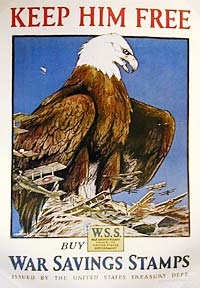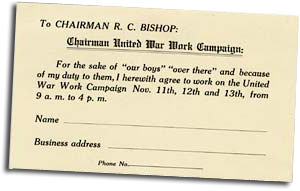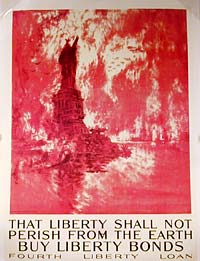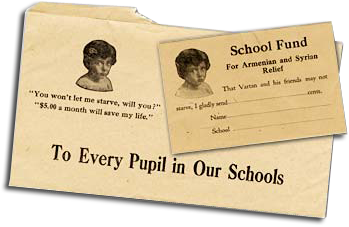A Home Front Battle Mentality
 Campaigns to encourage the purchase of War Savings Stamps were among several government fund raising programs. (Poster at Oregon State Archives, original at National Archives)
Campaigns to encourage the purchase of War Savings Stamps were among several government fund raising programs. (Poster at Oregon State Archives, original at National Archives)
Just as Red Cross volunteers dreamed up countless fund raising ideas, so did they participate in a wide range of drives. Examples included used clothing, linen for France, fruit pits, platinum, tin, and others. The drives took on the naming convention of the great battles of the war. Instead of the Second Battle of the Marne, on the home front it was the Second Christmas Roll Call and the Third Used Clothing Drive as waves of war drives rippled through the community.
Once again, citizens rose to the call. Despite its tiny population, residents of Union County contributed five tons of used clothing in the second drive. Local chapters were expected to meet quotas set by division staff. Most exceeded the quotas as was the case during the Second War Fund when in Clatsop County "the plan worked and Astoria was 'over the top' with the sum of $50,800.00 subscribed, our quota being $20,000.00."
Other drives and campaigns, both local and national, also competed for the attention of contributors as Oregonians were solicited countless times for fund drives and campaigns over the course of the war.
United War Work Campaign
The United War Work Campaign represented several prominent organizations active in providing services to those in the military. The group, consisting of the YMCA, YWCA, National Catholic War Council, Knights of Columbus, Jewish Welfare Board, War Camp Community Service, American Library Association, and Salvation Army, sought to raise over 170 million dollars for the campaign.
 The United War Work Campaign enlisted large numbers of volunteers to canvass Oregon for support. (OSA, Oregon Defense Council Records, Publications and Ephemera, Box 9, Folder 1)
The United War Work Campaign enlisted large numbers of volunteers to canvass Oregon for support. (OSA, Oregon Defense Council Records, Publications and Ephemera, Box 9, Folder 1)
The campaign went to great pains to point out that the houses and huts of each of the seven component organizations were "opened freely to men of all faiths" since "differences in creed and dogma do not divide men who are fighting and dying together."
The organizations touted their range of services in camps from basketball to motion pictures to various classes. The YWCA even maintained "hostess houses...where mother and sister and sweetheart may make their headquarters when they visit." Beyond the military camps, the organizations provided clubs and morale boosting services in cities for visiting soldier and sailors. The help even extended to the trenches of France where "down the trench he [the campaign worker] comes with chocolate and cigarettes and doughnuts and hot coffee or cocoa."
More than 15,000 uniformed workers engaged in a range of duties, acting as secretaries, athletic directors, librarians, lecturers, entertainers, truck drivers, motion picture operators, and more. The organizations shipped more than 500 tons of supplies weekly for the war effort. From July 1917 to August 1918, just one of the group's organizations shipped a staggering 848 million cigarettes, 32 million cigars, 14 million packages of chewing gum, and 10 million pounds of sugar.
The campaign also shipped American culture in the form of hundreds of actors and actresses performing in the "Over There Theatre League, " under the direction of George M. Cohen. Motion pictures, starring Mary Pickford, Charlie Chaplin, and Douglas Fairbanks, were enjoyed by 2.5 million a week, including "the boys all the way to the front line." View "
What Your Money Is Doing for Your Boys" booklet. (PDF)
 The Statue of Liberty under attack in an glimpse at an alternate future designed to motivate the purchase of bonds. Four liberty loan campaigns raised billions of dollars to fund the war. (Poster at Oregon State Archives, original at National Archives)
The Statue of Liberty under attack in an glimpse at an alternate future designed to motivate the purchase of bonds. Four liberty loan campaigns raised billions of dollars to fund the war. (Poster at Oregon State Archives, original at National Archives)
At the end of the war, the Oregon state director of collections for the United War Work Campaign was proud of the state's accomplishment. According to the campaign's national treasurer, Oregon's "record of cash on hand in excess of her entire original quota was not exceeded by any other state...."
Liberty Loan Campaign
Overall, national campaigns brought in billions of dollars to finance the war and related services. The largest were the four liberty loan campaigns sponsored by the U.S. Treasury. At intervals during the war, the government invited the purchase of gold bonds. For example, the Fourth Liberty Loan Campaign offered six billion dollars worth of bonds through subscriptions available from Sept. 28 to Oct. 19, 1918.
Each state and county had quotas to meet for subscriptions and in Oregon these typically were exceeded, sometimes in spectacular fashion: Lincoln County took in 640% of its quota. To accomplish this level of subscriptions, organizers sent out armies of workers loaded with prospect cards, window placards, and application forms. The prospect cards included rating codes showing the amount of subscription expected from the person: "O=$50, M=$1000, A=$100, AO=$150, 2A=$200, Etc." Workers were instructed to work in pairs, stay in their district and "solicit everyone who receives any income of any kind."
View instruction sheets. (PDF)
The Oregon Highway Department, formed just a few years earlier, reported an enthusiastic response to the Liberty Loan Campaign in April 1918. At a road construction camp, a local committee of the campaign was invited to accompany a road contractor on visits to the workers. The contractor let the men know:
As luck would have it, the contractor had "his check book with him and his fountain pen in working order" so any man who wanted an advance on wages could step right up to buy a bond.
Once again, the combination of patriotism and public obligation worked to great effect. According to one highway engineer's report, just one work camp purchased more than $5,000 of bonds. And as an added benefit, "this entirely gratuitous assistance given by the men had such an enlivening effect upon them that I am pleased to report a distinct drop in unit costs due clearly to greater performances within the eight hour period since that date."
"Shall We Feast While Others Starve?
Oregonians were also asked to give generously to a variety of relief funds. In addition to "adopting" or funding the support of French orphans, calls were made to help those in Belgium, Russia, and elsewhere. One such relief effort aimed to help the starving women and children in the Near East.
 These contribution envelopes were part of an effort to raise relief funds for starving women and children in the Near East. The little boy Vartan helped put a face on the problem. (OSA, Oregon Defense Council Records, Publications and Ephemera, Box 9, Folder 1)
These contribution envelopes were part of an effort to raise relief funds for starving women and children in the Near East. The little boy Vartan helped put a face on the problem. (OSA, Oregon Defense Council Records, Publications and Ephemera, Box 9, Folder 1)
As the war wound down and the post war period began, reports of desperate conditions followed: "Conditions too appalling to contemplate. Children turned from orphanages, left to fight alone for life-inevitably to perish." Reports followed describing 150,000 refugees in the hills of Baghdad with hundreds dying daily and "women and children, naked and destitute in Mosul."
The state treasurer asked all Oregon students to contribute "nickels, dimes, and thrift stamps" to the effort. Small contributions would add up to real help: "Twenty children giving the value of a thrift stamp each would care for one child for a month." The alternative? Showing a picture of several orphans, the question reads: "Which ones would you pick out to die?"
View state treasurer's letter. (PDF)
Notes
(Oregon State Defense Council Records, State Historian's Correspondence, Box 1, Folder 16, 37; Publications and Ephemera, Box 8, Folder 3; Box 9, Folder 1; Oregon Department of Transportation Records, General Correspondence, Box 16, Liberty Loans, Folder 61)